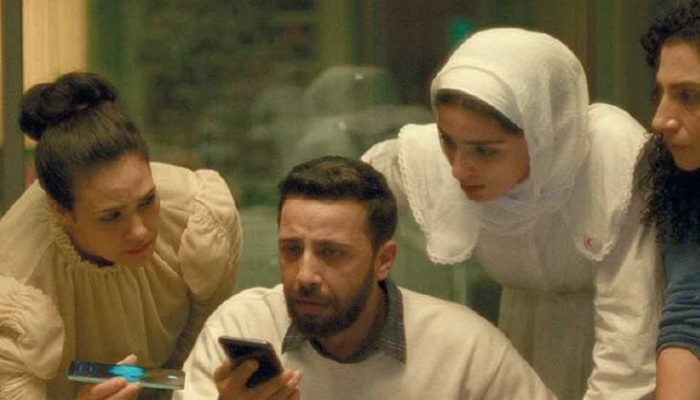
Afrasianet - Nisreen Sayed Ahmed - It 's hard to imagine that a film criticism task at a film festival could turn into writing a testimony to a genocide, and that the viewing seat would turn into a seat of consolation and lamentation. But that's exactly what Tunisian director Kawthar Ben Hania's "The Voice of Hind Rajab" does. It's not just a film that aspires to provoke a debate about form or style, but a full-fledged elegy, dedicated to a six-year-old Palestinian girl Omar, who was kidnapped by Israeli bullets and tanks on January 29, 2024.The story is known: Hind Rajab, the child trapped in her family's car in the Tal al-Hawa neighborhood of southern Gaza, surrounded by the bodies of her relatives, addresses the world on the phone in a trembling voice: "I am scared, come and take me."
The recording broadcast by the Palestinian Red Crescent Society at the time shook the conscience of humanity around the world. But the film does not only restore the cry, but also gives it a cinematic body, which formulates a dramatic and moral axis that makes the viewer a partner in the tragedy, a witness to what happened and is still going on. Ben Hania chose to make the sound the heart of the film, its axis and its compass.
There is no reenactment of the car scene, no archival footage of the child's face screaming for help, but a screen flooded with sound vibrations. We watch the film as if we are in front of a criminal document or a file that is kept in the archives, but it is in fact an open wound that drips pain every time it is replayed. No need for any visual beautification. Words alone are enough. The trembling of the voice, the child's breath, the echo of bullets in the background, all of this that no image can match.
However, the film does not only hand us the raw recording, but the sound surrounds a dramatic structure inside the Red Crescent call center in Ramallah. We see volunteers and staff, Omar (Moataz Melihs), Rana (Saja Kayyali), Mahdi (Amer Halihal), and Nisreen (Clara Khoury), taking calls, arguing about what can be done, trying to calm the child down, and then cracking under the weight of helplessness.
The scene is functional, like any call room for ambulance units, with offices, modern computers, screens displaying digital maps and ambulances moving slowly among the rubble. This cold everyday environment collides with the ugliness of what is heard, and the sense of the gap between normal life and ongoing catastrophe is multiplied.
At the heart of the film is a bitter moral struggle: Omar, who was the first to receive a call from Hind's uncle who lives in Germany, and the first to call Hind and hear her voice, wants to send an ambulance at all costs. Mahdi, his manager in the office, reminds him that any car moving without Israeli approval will be targeted immediately, and that dozens of medics have been killed in the past.
The tension is escalating between the humanitarian duty towards the besieged child and the other humanitarian duty of the desire to preserve the lives of the paramedics. The dispute is not personal, but rather a reflection of a situation that has been devoid of all capacity to act. The events take place in one room, the Red Crescent Communications Center, and you leave it only for a few moments.
Here is no hope in the end. We are witnessing a race against time that we already know is a loser. Every extra minute on the line strikes the viewer like a new stab, but we are absolutely certain that we are as helpless as the volunteers. We hear the voice, we wait for salvation, we hope for it and we know that it will not come.
But in "The Voice of Hind Rajab," this technique is at its limits: the documentary material here is overwhelming, unquestionable. There are those who will find that the emotional performance of the volunteers, with moments of bursting in tears and emotional tension, adds a layer of exaggeration that may weaken the power of the original recording, while Hind's real frightened and trembling voice suffices, without any dramatic additions. There are those who believe the opposite, and that this drama gives the viewer an outlet, a space in which to catch his breath from the horror of the sound, and allows the voice itself to be heard more clearly.
The truth is that the film oscillates between these two extremes. Sometimes every visual detail, digital maps, on-screen indicators, flaming dialogues, seems necessary to highlight the catastrophe. For example, knowing that the ambulance's route to the Hind site takes only eight minutes, while it takes hours and hours to coordinate the ambulance's journey with the Red Cross and get the green light from the IDF.
This is a piece of information that we learned from the dramatic context of the film, and without it we would not have known how difficult, even impossible, it would be to save the lives of many stranded injured. Other times, we feel that everything extra fades away at the sound of the child trapped by tanks and surrounded by the bodies of her relatives in the car.
But this same swing is part of the viewing experience: we oscillate like volunteers, between the desire to act and the wall of helplessness. What distinguishes "The Voice of Hind Rajab" is that it does not seek to prove the crime through direct political analysis, but rather lets the voice do the job. When she listens to a child begging for help amid her family's corpses, she doesn't need any rhetoric about Israeli brutality or absent international justice. The crime is written in a tone of fear, in the silence between the words, in the trembling of the little throat, in a simple sentence such as "I am afraid, come and serve me."
The film gives a voice to those who are voiceless and not usually heard. To make the child who has been left to her fate become an eternal witness, a presence that cannot be erased. This film is a cinematic testimony not only to Hind, but to all the children and civilians who are killed in Gaza without a name or a voice. At the same time, it is an unequivocal condemnation of the world that continues to watch as if it is not heard.
In some scenes, Ben Haniyeh puts us in front of a wall of pictures of other victims who died while calling the emergency line. Here, the film goes beyond Hind's individual case to remind us that her voice is not alone, but one of the thousands of voices that are interrupted in the middle of a sentence, thus the film also becomes an archive of absence, a collective memorial to victims without visible graves.
There is no doubt that "The Voice of Hind Rajab" is a difficult film, and it may even provoke controversy. Some will find in his melodramatic techniques a kind of emotional blackmail, while others will see it as a necessary cry in the face of appalling international indifference. But whatever the situation, the power of experience is undeniable.
The film forces its viewers to listen, from start to finish, without pausing or stopping buttons. It makes us captivated by the sound as the child was captive in her car. And that's exactly the power of cinema: it forces listening where the world wants to be deafened.

